

HONG KONG, Aug. 17 (Xinhua) -- Starting from June, Hong Kong's opposition and some radical forces have used the pretext of peaceful demonstration to engage in violent protests.
Though the Hong Kong Special Administrative Region (HKSAR) government said, on many occasions, that it has completely halted the amendments of two ordinances concerning the transfer of fugitive offenders, protesters continued to escalate violence and cause mayhem in Hong Kong.
Here is a timeline of these violent activities that are aimed to trample the rule of law, sabotage social order, undermine national sovereignty and the "one country, two systems" principle.
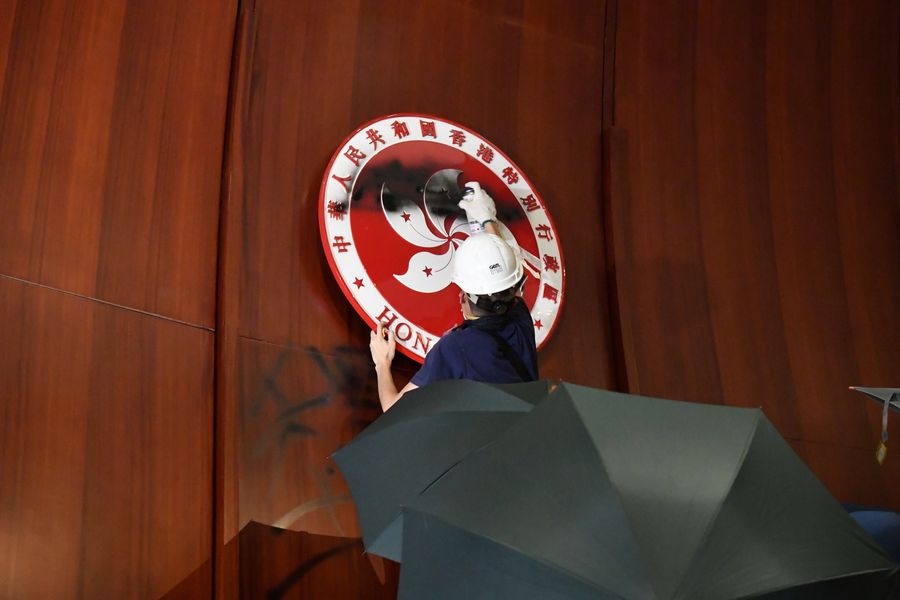
A violent radical vandalizes the regional emblem of Hong Kong Special Administrative Region after breaking and entering the Legislative Council building in Hong Kong, south China, July 1, 2019. (Xinhua)
CHALLENGING GOVERNANCE AUTHORITY
The demonstrations, which started in June, repeatedly became violent clashes under the instigation of individuals with ulterior motives. Some radicals repeatedly mounted attacks on police. They surrounded Hong Kong police headquarters, disrupted government agencies and ransacked the Legislative Council (LegCo) building.
-- On June 9, demonstrators started to protest against the proposed amendments. In the wee hours of June 10, well-organized radical protesters started attacking the LegCo building, blocking roads and assaulting police officers. They clashed with police, with some attempting to rob officers of their guns. Eight policemen were injured.
-- On June 12, an illegal rally started around Admiralty, and some radical members stayed around the LegCo building until midnight. Well-organized protesters assaulted officers with bricks, home-made spears and even petrol bombs, injuring 22 police officers. Though police exercised restraint, the protesters continually assaulted their line of defense and forced police to use appropriate force to disperse demonstrators.
-- On June 21, even after the HKSAR government announced that it had halted the amendments, violence continued. Extremist protesters surrounded police headquarters and wreaked havoc, and blocked the public from using service at the Revenue Tower and the Immigration Tower. Then they blocked Hong Kong government offices and the High Court.
-- On June 26, a few 'fanatics' instigated demonstrators to storm police headquarters for the second time. They repeated similar savage behaviors. Opposition lawmakers were once again present to provide support. The personal data of some police officers was illegally leaked online.
-- On July 1, rioters blocked roads and threw corrosive liquids at police officers. They ransacked the LegCo building and assailed police with toxic chemical powder. They extensively damaged the council chamber, defaced HKSAR regional emblem, tore up the Basic Law, waved a colonial-era flag and even called for an establishment of a so-called "interim government."

Violent radicals attempt to break and enter the Legislative Council building in Hong Kong, south China, July 1, 2019. (Xinhua)
DISTURBING SOCIAL ORDER
Hong Kong's social disorder worsened in July, as aggressive members unlawfully assembled or launched more demonstrations in various districts of Hong Kong. Violence spread further, affecting the normal lives of more residents.
-- On July 6, disputes broke out in Tuen Mun district between protesters and residents. Residents were besieged, beaten and kicked by radicals. Protesters occupied roads and sieged Tuen Mun police station.
-- On July 7, protesters organized another demonstration in Kowloon, leading to a 50-percent plunge in passengers through West Kowloon high-speed train station, compared with an average weekend. Only 31,000 passengers traveled through the station on that day. After the demonstration, some radical protesters illegally blocked roads in Tsim Sha Tsui, forcing most shops to close early in the once trendy shopping area.
-- On July 13, a demonstration in Sheung Shui district ended with violent clashes with the police. A few radical protesters dismantled iron bars, blocked main roads, beat and attacked police officers with umbrellas, iron bars, suspected toxic powders and corrosive liquids. At least 16 police officers were injured. At night, the radical members continued to sabotage stores in the district. The police then launched a clearance operation in accordance with the law.
-- On July 14, some radical protesters removed the roadside fence in Sha Tin district to block roads, sharpened bamboo branches as weapons, hurled bricks, umbrellas and other debris at police officers from high buildings. Fierce clashes broke out at New Town Plaza, injuring at least 10 police officers. An officer in plain clothes was attacked by a mob. Some officers were left with facial fractures. One police officer's finger was bitten off.
-- On July 27, though the Hong Kong police had issued a notice of objection, some people assembled illegally at the Yuen Long district. A group of radical protesters illegally cut off traffic, sieged police vehicles, smashed car windows and smeared cars with insulting words. Police officers were deployed at the village entrances to prevent conflicts between protesters and villagers. Several radical protesters also sieged the Yuen Long police station, forcing the report room to suspend service. Opposition lawmakers were once again present to support the violent acts.
-- On July 28, a number of radical protesters carried out illegal demonstrations in the central and western parts of Hong Kong Island, seriously hindering traffic. They dug up pavement bricks, destroyed street signs and lampposts, set fires on multiple roads and charged police lines. Violence again escalated, as some people carried lethal weapons such as bows and arrows and petrol bombs.
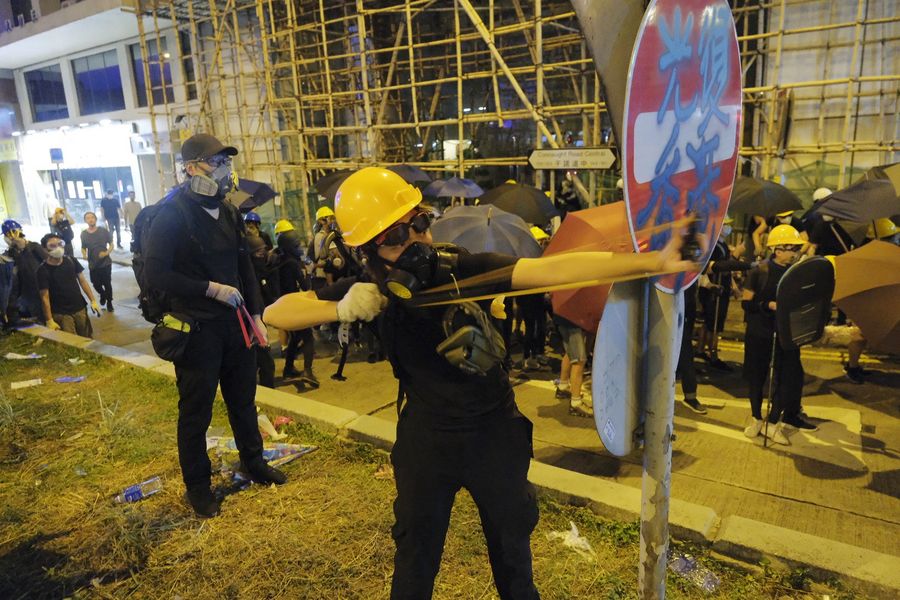
A violent radical attacks the police with a slingshot in Sheung Wan, south China's Hong Kong, July 28, 2019. (Xinhua)
UNDERMINING "ONE COUNTRY, TWO SYSTEMS" PRINCIPLE
A group of extreme radicals stormed the offices of the Central Government in Hong Kong, insulted the national emblem and flag of China, undermined national sovereignty and dignity and the "one country, two systems" principle.
-- On July 21, radical protesters besieged and attacked the Liaison Office of the Central People's Government, defaced the national emblem in front of the building by hurling eggs and black paintballs, damaged security facilities and scrawled graffiti insulting the nation.
They even raved about forming an "interim legislature" in a statement read out on the scene.
-- On July 28 and Aug. 4, some radical protesters mounted more attacks at the liaison office but were thwarted by riot police.
-- On Aug. 3 and on Aug. 5, black-clad and masked extreme radicals twice ripped the Chinese national flag off the pole in Tsim Sha Tsui, flung it into the sea, in clear defiance of national sovereignty.
On July 26, police arrested a suspect on suspicion of desecrating the national emblem.
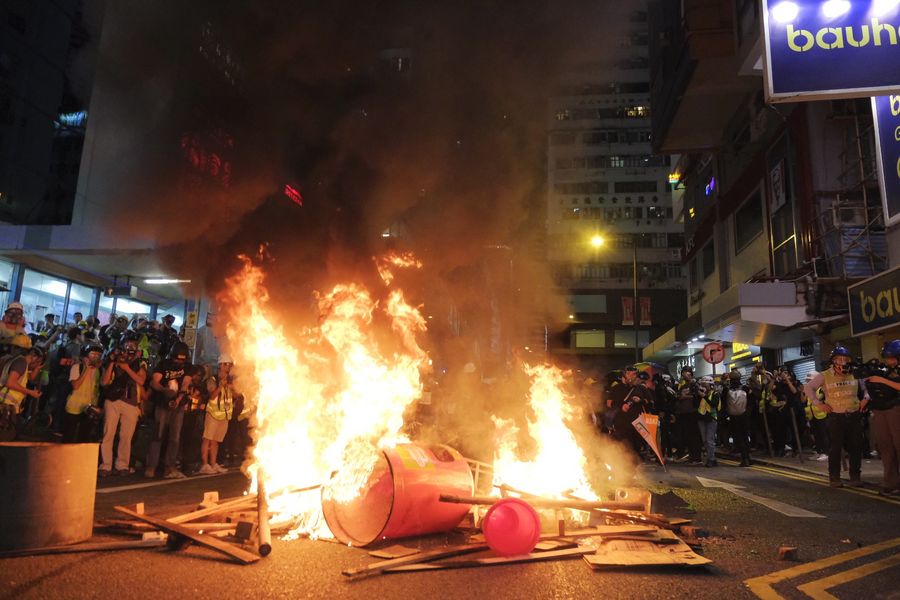
Violent radicals set fires after blocking a road in Causeway Bay, south China's Hong Kong, Aug. 4, 2019. (Xinhua)
PUSHING HONG KONG TO BRINK
Violence and chaos escalated in August as mobsters used guerrilla tactics to stage strikes, block public transport, prevent residents from going to work, damage public facilities, siege police stations and attack police officers across Hong Kong, pushing the city to the brink.
-- On Aug. 3, radical protesters sabotaged areas in Yau Ma Tei, Tsim Sha Tsui and Mong Kok. They blocked the Cross-Harbor Tunnel twice, paralyzing traffic between Hong Kong Island and Kowloon. They charged police stations in Tsim Sha Tsui, Mong Kok and Wong Tai Sin, scribbled words to insult and provocate the police, ruined police vehicles and started fires in front of police stations.
-- On Aug. 4, protesters caused considerable damage in western Hong Kong Island, Causeway Bay and Tseung Kwan O by blocking roads and storming several police stations. They later flocked to Hung Hom to block the Cross-Harbor Tunnel and the Golden Bauhinia Square to smear the sculpture.

Violent radicals go after a police vehicle in North Point, south China's Hong Hong, Aug. 5, 2019. (Xinhua)
-- On Aug. 5, flash mobs stirred up trouble across Hong Kong. They destroyed public facilities, including roadside railings, sidewalk bricks, traffic bollards and lights. As a result, 36 roads and the Cross-Harbor Tunnel were blocked, 96 buses suspended or rerouted, 8 MTR lines obstructed and more than 200 flights canceled.
From the night of Aug. 5 to the wee hours of the following day, some radical protesters raided at least 10 police stations. They scribbled words to insult police, hurled petrol bombs and firebombs at police stations and officers, shot vision-harming lasers, ruined police cars, and caused mayhem on several streets, police stations and buildings. They also cut off power lines.
-- On Aug. 11, protesters threw petrol bombs and wounded at least one policeman.
-- On the evening of Aug. 13 and early on Aug. 14, shockingly violent acts occurred at the Hong Kong International Airport. Some violent radicals attending an unlawful assembly at the airport inflicted severe physical harm to two mainland residents.
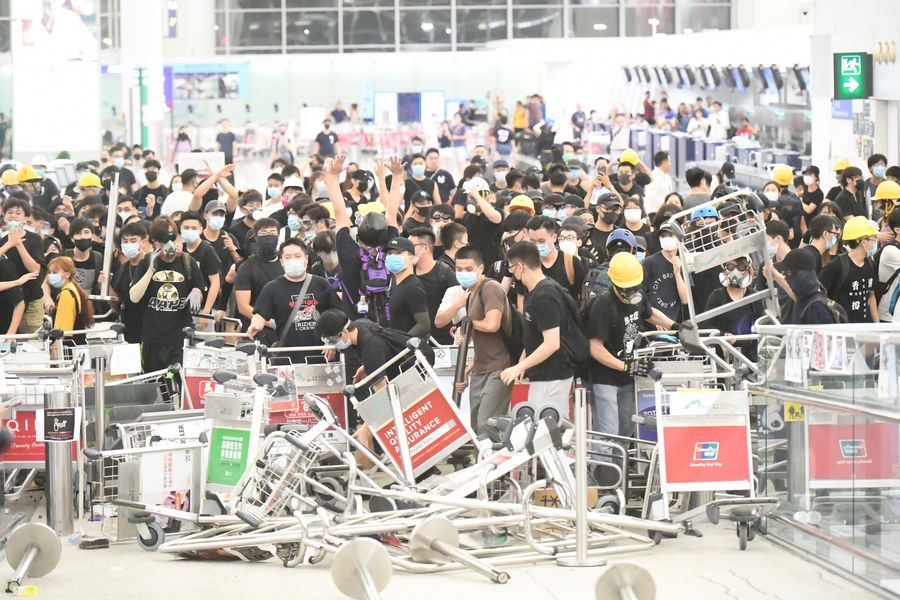
Violent radicals block a passage at Hong Kong International Airport in south China's Hong Kong, Aug. 13, 2019. (Xinhua)
Around 8:00 p.m. local time on Aug. 13, they unlawfully detained a resident from Shenzhen surnamed Xu, who held a Hong Kong and Macao travel permit for private visit purposes and was at the airport to see people off. They tied him up, shot a laser at his eyes and beat him into a coma. They also obstructed the way for an ambulance crew to take him to hospital. With the help of the police, it took nearly four hours for Xu to be rescued. As the events played out, they also sieged and assaulted a police officer and snatched his baton.
After midnight of Aug. 14, some violent radicals tied up both hands of a Global Times reporter surnamed Fu and beat him in the name of suspecting him to be a fake reporter, causing multiple injuries to Fu.
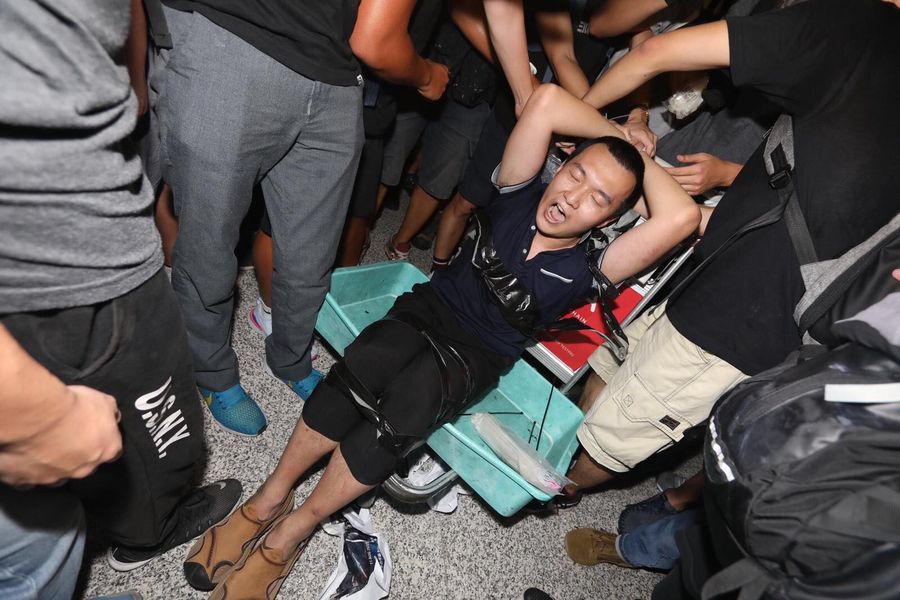
Violent radicals illegally seize a reporter with "Global Times", a Beijing-based newspaper, at Hong Kong International Airport in south China's Hong Kong, Aug. 13, 2019. (Xinhua)
The radical protesters have become better-equipped, coordinated and planned, and they have continued to push the level of violence to new heights. Alarmingly, many weapon depots containing explosives, firebombs and knives suspected to be owned by radical protesters have been uncovered in police operations.
From June 9 to Aug. 6, the Hong Kong police arrested 589 people suspected of illegal assembly, rioting and assaulting the police.
What is more alarming is that anti-China forces in the West have colluded with local anti-China forces who intend to mess up Hong Kong. On multiple occasions, foreign nationals were seen meeting and talking with radical protesters. Recently, leaders of "Hong Kong independence" groups secretly met with officials of the U.S. Consulate General in Hong Kong. The day after their meeting, the groups said on social media that they plan to boycott classes in September.
It is incontrovertibly evident and without question that the Hong Kong opposition camp and radical groups have colluded with foreign forces. Certain forces in the U.S. and Britain have deliberately ignored extreme violence in the illegal protests and attempted to beautify mobsters as campaigners of "freedom, democracy and human rights."
During the recent riots, the Hong Kong Police Force has honored their duties and enforced the law with professionalism and great restraint. The Hong Kong police have been a pillar in safeguarding Hong Kong's social security and the last shield to uphold its social stability. It has maintained its reputation as one of the world's most outstanding police forces. From June 9 to Aug. 5, 139 officers suffered injuries on duty.
Looking back at what happened during the past two months, the ordinance amendment issues have changed in their essence and now bear the features of a "color revolution."
Should violence and chaos be allowed to continue, the safety of Hong Kong citizens' lives and property will be endangered, and the governance authority of the SAR government, the cornerstone of the rule of law in Hong Kong, its prosperity and stability, and the "one country, two systems" will be destroyed. Citizens of Hong Kong will not allow this to happen. The people of China will not allow this to happen.
On Aug. 7, the Hong Kong and Macao Affairs Office of the State Council and the Liaison Office of the Central People's Government in Hong Kong jointly held a symposium in Shenzhen, south China's Guangdong Province, briefing the attendees on the central authorities' policies on stabilizing Hong Kong's situation. It stressed that the most pressing and overriding task in Hong Kong is to stop violence, end the chaos and restore order.
The recent violence in Hong Kong is intolerable in any civilized, rational society under the rule of law. Any illegal and criminal acts that blatantly defy the basic principle of "one country, two systems," trample the rule of law, destroy social stability and infringe public interest will be brought to justice.

 Award-winning photos show poverty reduction achievements in NE China's Jilin province
Award-winning photos show poverty reduction achievements in NE China's Jilin province People dance to greet advent of New Year in Ameiqituo Town, Guizhou
People dance to greet advent of New Year in Ameiqituo Town, Guizhou Fire brigade in Shanghai holds group wedding
Fire brigade in Shanghai holds group wedding Tourists enjoy ice sculptures in Datan Town, north China
Tourists enjoy ice sculptures in Datan Town, north China Sunset scenery of Dayan Pagoda in Xi'an
Sunset scenery of Dayan Pagoda in Xi'an Tourists have fun at scenic spot in Nanlong Town, NW China
Tourists have fun at scenic spot in Nanlong Town, NW China Harbin attracts tourists by making best use of ice in winter
Harbin attracts tourists by making best use of ice in winter In pics: FIS Alpine Ski Women's World Cup Slalom
In pics: FIS Alpine Ski Women's World Cup Slalom Black-necked cranes rest at reservoir in Lhunzhub County, Lhasa
Black-necked cranes rest at reservoir in Lhunzhub County, Lhasa China's FAST telescope will be available to foreign scientists in April
China's FAST telescope will be available to foreign scientists in April